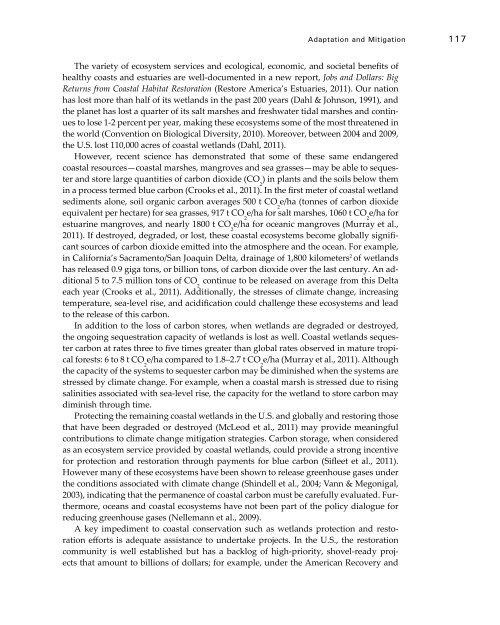Coastal Impacts, Adaptation, and Vulnerabilities - Climate ...
Coastal Impacts, Adaptation, and Vulnerabilities - Climate ...
Coastal Impacts, Adaptation, and Vulnerabilities - Climate ...
You also want an ePaper? Increase the reach of your titles
YUMPU automatically turns print PDFs into web optimized ePapers that Google loves.
<strong>Adaptation</strong> <strong>and</strong> Mitigation 117The variety of ecosystem services <strong>and</strong> ecological, economic, <strong>and</strong> societal benefits ofhealthy coasts <strong>and</strong> estuaries are well-documented in a new report, Jobs <strong>and</strong> Dollars: BigReturns from <strong>Coastal</strong> Habitat Restoration (Restore America’s Estuaries, 2011). Our nationhas lost more than half of its wetl<strong>and</strong>s in the past 200 years (Dahl & Johnson, 1991), <strong>and</strong>the planet has lost a quarter of its salt marshes <strong>and</strong> freshwater tidal marshes <strong>and</strong> continuesto lose 1-2 percent per year, making these ecosystems some of the most threatened inthe world (Convention on Biological Diversity, 2010). Moreover, between 2004 <strong>and</strong> 2009,the U.S. lost 110,000 acres of coastal wetl<strong>and</strong>s (Dahl, 2011).However, recent science has demonstrated that some of these same endangeredcoastal resources—coastal marshes, mangroves <strong>and</strong> sea grasses—may be able to sequester<strong>and</strong> store large quantities of carbon dioxide (CO2) in plants <strong>and</strong> the soils below themin a process termed blue carbon (Crooks et al., 2011). In the first meter of coastal wetl<strong>and</strong>sediments alone, soil organic carbon averages 500 t CO2e/ha (tonnes of carbon dioxideequivalent per hectare) for sea grasses, 917 t CO2e/ha for salt marshes, 1060 t CO2e/ha forestuarine mangroves, <strong>and</strong> nearly 1800 t CO2e/ha for oceanic mangroves (Murray et al.,2011). If destroyed, degraded, or lost, these coastal ecosystems become globally significantsources of carbon dioxide emitted into the atmosphere <strong>and</strong> the ocean. For example,in California’s Sacramento/San Joaquin Delta, drainage of 1,800 kilometers 2 of wetl<strong>and</strong>shas released 0.9 giga tons, or billion tons, of carbon dioxide over the last century. An additional5 to 7.5 million tons of CO2continue to be released on average from this Deltaeach year (Crooks et al., 2011). Additionally, the stresses of climate change, increasingtemperature, sea-level rise, <strong>and</strong> acidification could challenge these ecosystems <strong>and</strong> leadto the release of this carbon.In addition to the loss of carbon stores, when wetl<strong>and</strong>s are degraded or destroyed,the ongoing sequestration capacity of wetl<strong>and</strong>s is lost as well. <strong>Coastal</strong> wetl<strong>and</strong>s sequestercarbon at rates three to five times greater than global rates observed in mature tropicalforests: 6 to 8 t CO2e/ha compared to 1.8–2.7 t CO2e/ha (Murray et al., 2011). Althoughthe capacity of the systems to sequester carbon may be diminished when the systems arestressed by climate change. For example, when a coastal marsh is stressed due to risingsalinities associated with sea-level rise, the capacity for the wetl<strong>and</strong> to store carbon maydiminish through time.Protecting the remaining coastal wetl<strong>and</strong>s in the U.S. <strong>and</strong> globally <strong>and</strong> restoring thosethat have been degraded or destroyed (McLeod et al., 2011) may provide meaningfulcontributions to climate change mitigation strategies. Carbon storage, when consideredas an ecosystem service provided by coastal wetl<strong>and</strong>s, could provide a strong incentivefor protection <strong>and</strong> restoration through payments for blue carbon (Sifleet et al., 2011).However many of these ecosystems have been shown to release greenhouse gases underthe conditions associated with climate change (Shindell et al., 2004; Vann & Megonigal,2003), indicating that the permanence of coastal carbon must be carefully evaluated. Furthermore,oceans <strong>and</strong> coastal ecosystems have not been part of the policy dialogue forreducing greenhouse gases (Nellemann et al., 2009).A key impediment to coastal conservation such as wetl<strong>and</strong>s protection <strong>and</strong> restorationefforts is adequate assistance to undertake projects. In the U.S., the restorationcommunity is well established but has a backlog of high-priority, shovel-ready projectsthat amount to billions of dollars; for example, under the American Recovery <strong>and</strong>
















